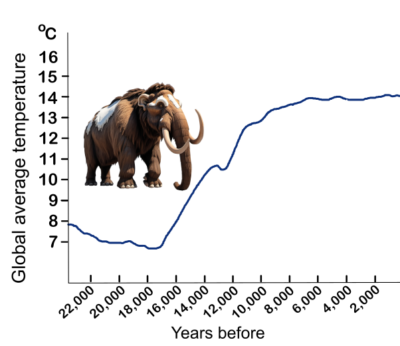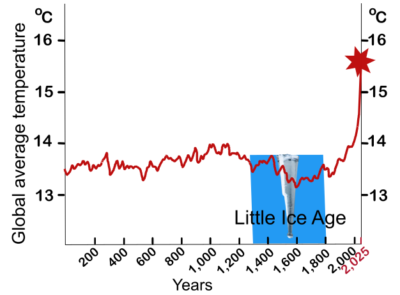7.1Climate Change
backToday was scorching hot, again! The news said this is the 27th record‐breaking day in a row. I keep thinking about Grandma’s Venus story. She always warned us not to let Earth ‘turn into another oven!’
I decided to do a little research in my spare time (when the air conditioner was finally working!). As I dug deeper, I learned Earth’s climate has always had its ups and downs, just not usually so fast.
I found an amazing graph showing Earth’s temperatures over the last 20,000 years. At first, it was a wild roller coaster.

20,000 years ago we were smack in the middle of an Ice Age! Mammoths roamed, glaciers covered huge parts of the world, and people lived in caves or small huts to stay warm. Then, slowly, the planet warmed, and the big ice sheets melted. Lakes and rivers formed as the ice retreated, and new plants spread north.

We don’t have to go back too far in time to see big changes in climate. The Little Ice Age, which lasted from about the 1300s to the 1800s, brought colder and more unpredictable weather worldwide. In England, rivers that rarely froze were covered with thick ice, and winters were harsher than usual. Across the globe, temperatures dropped, and weather patterns became unreliable. In Asia, weaker monsoons failed to bring enough water, leading to dry seasons and struggles for farmers. Colder winters and unpredictable weather caused crops to fail in many regions, leaving people to face starvation and hardship. It makes you wonder,what would be easier to survive: an ice age or a planet that’s too hot to live on?
Everything I read stressed one big idea: these changes used to take thousands, even millions, of years. Earth did change all on its own, but very slowly. Quick changes don’t leave enough time for us to adapt. A little warming might seem harmless, maybe even saving on heating bills in colder areas, but this is happening too fast and too much to be safe.
If temperatures keep rising at this speed, what will our summers look like in ten or twenty years? Or will we be looking for a new planet, like Grandma once did?
Suddenly, I couldn’t help comparing Earth’s warming spike on that graph to what happened on Venus, except it’s happening much faster than any natural cycle I read about. Scientists say it’s because we’re burning fuels and chopping down forests, which adds extra greenhouse gases to the atmosphere. Grandma said that’s exactly how Venus got in trouble and its atmosphere turned into a heat‐trap.
I wondered, Could we actually be repeating the same mistake here on Earth?
- Read from the first graph:
- Our civilization began around 10,000 years ago. What has the temperature been like since then? Stable or changing quickly?
- Read from the second graph:
- How much did the temperature drop during the Little Ice Age?
- How much has the temperature risen since the year 2000?
- If you lived during the Ice Age, how would you stay warm? What challenges would you face?
- What do you think life was like during the Little Ice Age? What would you do for fun if rivers froze in winter?
- Earth’s climate is changing faster today than ever before. How do you think this might affect your daily life in the future?
